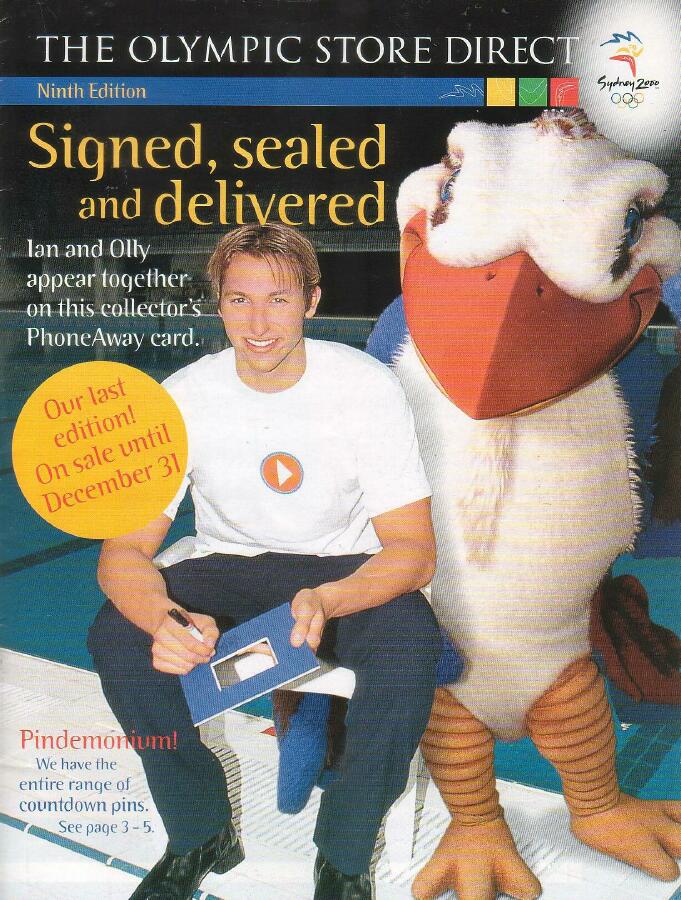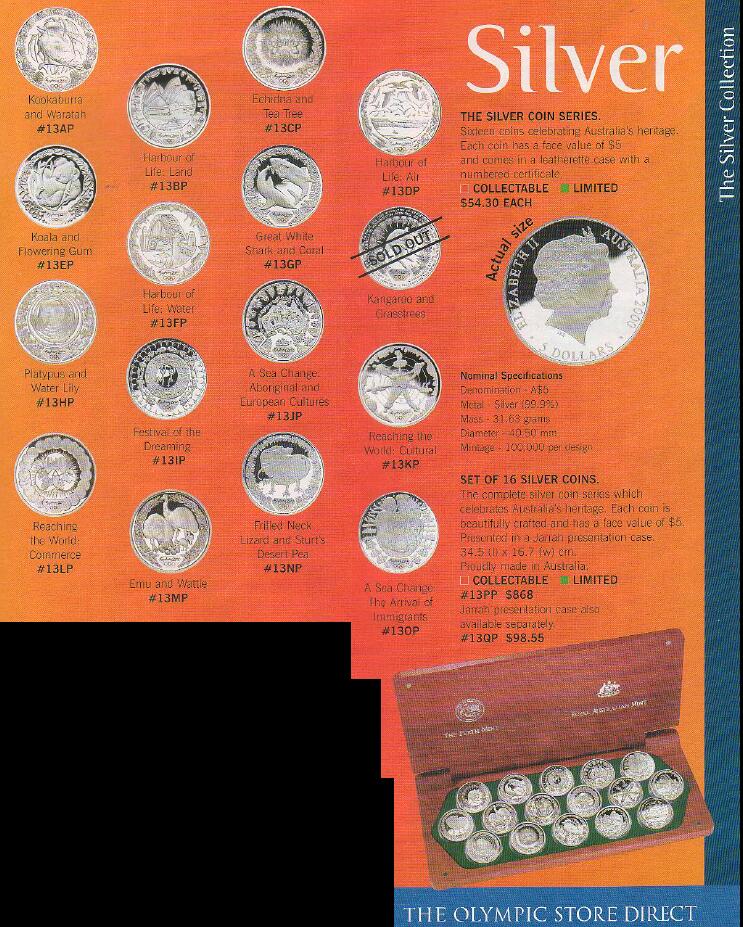

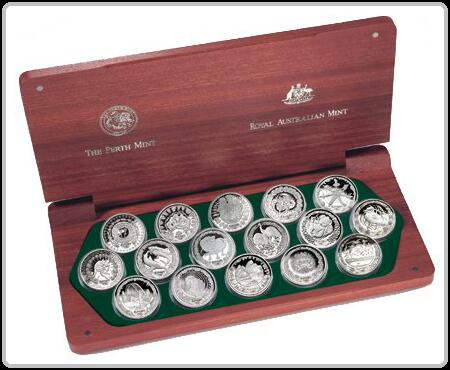

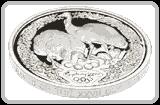

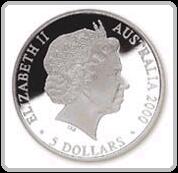

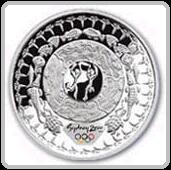
CULTURAL RELEASE ONE - 'Festival of the Dreaming' - October
1997
The image on the reverse of this coin was designed
by Aboriginal artist and Olympic gold medalist, Nova Peris-Kneebone,
and master coin artist, Stuart Devlin
The figures in the centre of the design depict two people
The circle around them represents their dreams, the smaller dots
their family and friends
The waves symbolise the obstacles they must overcome, while the
stars symbolise the notion that the sky is the limit to accomplishment
if dreams are backed by dedication
A variety of Australian sea-life - reef fish, stingrays, crocodiles,
sea snakes and turtles - make up the elaborate border, together
with the Millennium Athlete of the Sydney 2000 Olympic Games logo
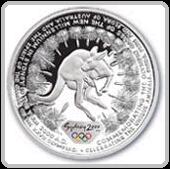
ENVIRONMENTAL RELEASE ONE - 'Kangaroo & Grasstrees'
- October 1997
One of the most widely recognised symbols of Australia,
the kangaroo, is the centerpiece of this attractive design, which
celebrates Australia's unique flora and fauna
The animal is depicted in typical pose, carrying a baby (or 'joey')
in her pouch
The kangaroos are surrounded by native Xanthorrhoea plants, commonly
known as Grasstrees, or by their Aboriginal name - 'Balga' trees
The perimeter of the coin features the inscription: "Commemorating
the Olympic Games of the new Millennium in Sydney in the Year
2000 AD. Celebrating the unique animals, birds, fish and flora
of Australia and the spirit of the Games of the XXVII Olympiad"
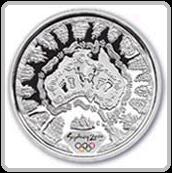
CULTURAL RELEASE TWO - 'A Sea Change I' - April 1998
The theme of reconciliation and co-operation is symbolised
in an image representing the story of the discovery and settlement
of Australia
Sailing ships, which transported the European explorers and colonists,
surround the 'Mother Country'
Two human figures and footprints represent Australia's indigenous
and non-indigenous population, standing together as one - a symbol
of reconciliation and harmony
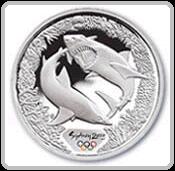
ENVIRONMENTAL RELEASE TWO - 'Great White Shark & Coral'
- April 1998
The Great White Shark, the most feared predator in
Australian waters, is the focal point of this striking design
An ancient, perfectly adapted marine creature, the Great White
Shark has been hunted ruthlessly and is now an endangered species
The sharks are surrounded by a border of coral and seaweed found
in Australian waters
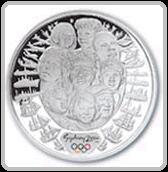
CULTURAL RELEASE THREE - 'A Sea Change II' - September 1998
This design focuses on Australia's evolution as a multicultural
society
The image depicts a central, wise Aboriginal elder, surrounded
by Australians of diverse ethnic backgrounds symbolising both
the starting point and development of Australian society
The border comprises the ships and aircraft that brought to Australia
the immigrants who shaped and enriched the nation's culture and
way of life
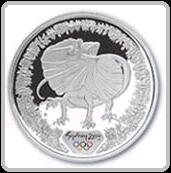
ENVIRONMENTAL RELEASE THREE - 'Frill-necked lizard-Sturt's
Desert Pea' - September 1998
The third silver coin in the 'environmental' series
features two of Australia's most famous natural treasures - the
Frill-necked lizard, in typical aggresive pose, and an elaborate
border of the flowers, buds and foliage of Sturt's Desert Pea,
both found in Australia's tropical north
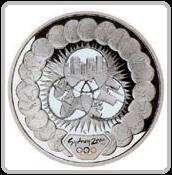
CULTURAL RELEASE FOUR - 'Reaching the World I' - April 1999
'Reaching the World I' celebrates Australian achievements
in commerce, industry and technology
The design incorporates the commercial districts of Melbourne,
the distinctive towers and chimneys of a large industrial power
station, and satellite dishes that link Australia to the world
through latest communications technology
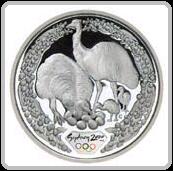
ENVIRONMENTAL RELEASE FOUR - 'Emu & Wattle' - April
1999
'Emu and Wattle' features two of Australia's most famous
flora and fauna
Two adult emus caring for two chicks and a clutch of unhatched
eggs are the focus of the design
The emu also features on the Australian Coat of Arms, and is the
second tallest of the world's flightless birds, reaching two metres
in height
A border of Australia's national flower, the wattle, frames the
group
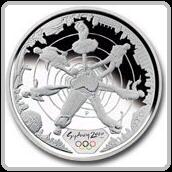
CULTURAL RELEASE FIVE - 'Reaching the World II' - September
1999
Australia's achievements in sport and the arts are
celebrated in this coin design by Stuart Devlin
Figures representing ballet, painting, opera, pop music, athletics,
golf and soccer radiate out from a map of Australia
They are framed by a border of famous international arts and sports
venues at which Australians have performed or had their work showcased
The venues are interspersed with cityscapes from around the world
The venues are (clockwise from bottom left) the Royal Albert Hall,
London, the Olympic Sports Halls, Tokyo, the Gugenheim Museum,
New York, Wembley Stadium, London, the Metropolitan Opera House,
New York and the Palezetto dello Sport, Rome
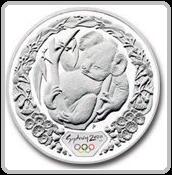
ENVIRONMENTAL RELEASE FIVE - 'Koala & Flowering Gum'
- September 1999
One of Australia's most endearing ambassadors, the
koala, is the central feature of the reverse design by Stuart
Devlin
A much-loved symbol of Australia, and a favourite with international
visitors, the koala wins hearts the world over with its cuddly
appearance
It prefers to live high up in selected species of eucalypt trees,
on whose leaves it dines, and, like all marsupials, it carries
its young in its pouch
The koala derives its fluid requirements from the leaves and seldom
needs to drink water
Koalas live for about 10 years in the wild and tend to live solitary
lives
The border design is based on one of Australia's most beautiful
trees, the Red Flowering Gum
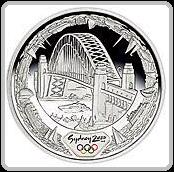
CULTURAL RELEASE SIX - 'Harbour of Life (Water)' - February
2000
The Sydney Harbour Bridge, one of Australia’s
most famous landmarks, is depicted on the reverse of the silver
‘Harbour of Life’ coin, designed by Stuart Devlin
Known affectionately as ‘The Big Coathanger’, the Sydney
Harbour Bridge officially opened in 1932 and will provide a spectacular
backdrop for the Olympic sailing and triathlon competitions, as
well as a focal point for the Olympic Arts Festival
The border design shows the myriad of vessels - ferries, yachts,
cruiseliners and pleasurecraft - that traverse Sydney harbour
daily
‘Harbour of Life’ is the theme of the fourth festival
in the Sydney 2000 Cultural Olympiad
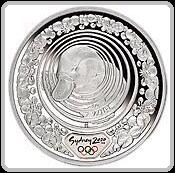
ENVIRONMENTAL RELEASE SIX - 'Platypus & Water Lily'
- February 2000
The platypus, one of Australia's most unique creatures,
is the central feature of the reverse design by Stuart Devlin
The platypus is the inspiration for Syd, one of the three Olympic
Games Mascots
It is one of only three egg laying mammals in the world, known
collectively as monotremes
Well-equipped for its semi-aquatic lifestyle, with webbed feet,
streamlined body and flattened tail, the platypus inhabits the
lakes, rivers and streams of eastern Australia
A border of Australian water lillies surrounds the design
With violet flowers and broad flat leaves, these plants create
a spectacular sight in tropical Australian wetlands
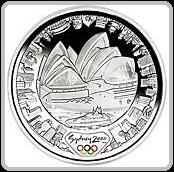
CULTURAL RELEASE SEVEN - 'Harbour of Life (Land)' - March
2000
The Sydney Opera House is an instantly reconisable
Australian icon
It was designed by renowned Danish architect Jorn Utzon and was
officially opened by Queen Elizabeth II in 1973
The central image is surrounded by a border of historic and modern
Sydney city buildings including the AMP Tower, the Sydney Observatory,
the Chinese Garden Pagoda, Horby Lighthouse and the Sydney Convention
Centre
'Harbour of Life' is the theme of the fourth festival in the Sydney
2000 Cultural Olympiad
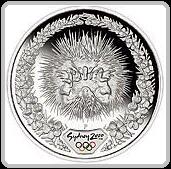
ENVIRONMENTAL RELEASE SEVEN - 'Echidna & Tea Tree' -
March 2000
The echidna, which features on the reverse of this
coin, is one of Australia's most interesting native animals
It is the inspiration for Millie, one of the three Sydney 2000
Olympic Games Mascots
Commonly known as the 'spiny anteater', the echidna is covered
with sharp spiky hairs and has a tubular snout and long sticky
tongue
It is a monotreme - an egg-laying mammal - with a pouch to protect
its young
A border of tea tree flowers and leaves surrounds the echidna
design
The tea tree is a small paperbark tree with narrow leaves and
five-petal flowers
Some species contain an essential oil that is recognised internationally
for its antiseptic properties
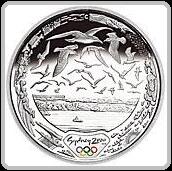
CULTURAL RELEASE EIGHT - 'Harbour of Life (Air)' - March
2000
The coin depicts Sydney Harbour, looking towards the
entrance of the harbour, or 'Heads', from the city
It shows the sea and the land, dominated by the air above
Fort Denison is depicted in the middle of the harbour
Built on Rock Island, the fort was completed in 1857 to protect
Sydney from invasion and is now part of Sydney Harbour National
Park
Gliding and diving sea gulls complete the design
The border of the coin shows the diverse weather conditions experienced
throughout this vast country
Rain, wind, sun, snow, clouds and clear skies are all represented
'Harbour of Life' is the theme of the fourth festival in the Sydney
2000 Cultural Olympiad
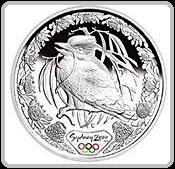
ENVIRONMENTAL RELEASE EIGHT - 'Kookaburra & Waratah'
- March 2000
The Kookaburra features as the cetral image of the
reverse design by Stuart Devlin
The kookaburra is the inspiration for Olly, one of three Sydney
Olympic Games Mascots
It is known for its distinct call, which sounds like human laughter
but is actually a warning to intruders
The largest member of the kingfisher family, the kookaburra can
be found in most parts of Australia feeding on lizards, insects,
small rodents and snakes
The kookaburra design is surrounded by a border of the flowers
and leaves of the waratah, one of Australia's most spectacular
native plants
It has crimson flowers with leathery spiked leaves and is the
floral emblem of New South Wales
